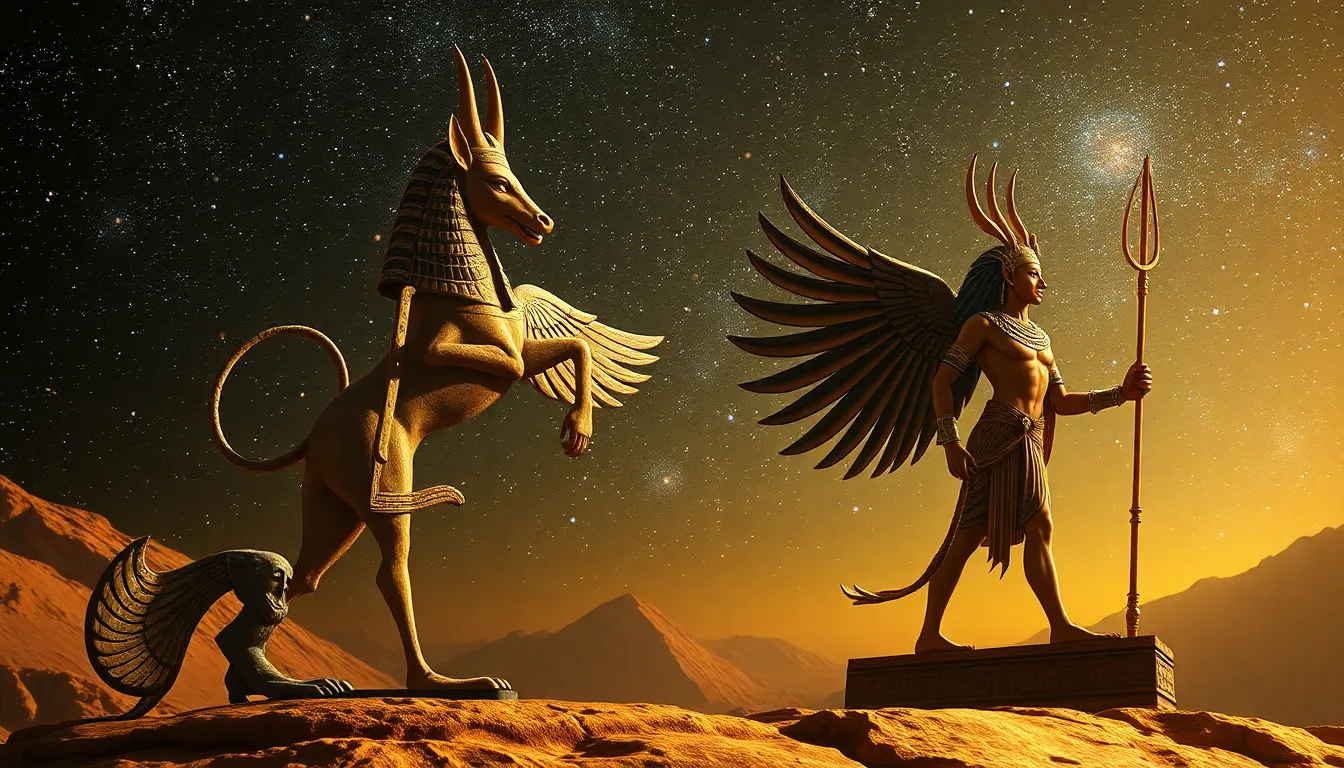Celestial Deities: The Star Myths of Ancient Egypt
I. Introduction
In ancient cultures, celestial deities played a crucial role in the understanding and interpretation of the cosmos. These deities, often associated with stars, planets, and celestial phenomena, were revered and worshipped, reflecting the societies’ beliefs about the universe and their place within it. In Ancient Egypt, star myths were integral to religious practices, influencing everything from daily life to governance.
This article aims to explore the celestial deities of Ancient Egypt, the myths surrounding them, and their significance in the broader context of Egyptian mythology and culture.
II. Historical Context of Ancient Egyptian Religion
Ancient Egyptian religion was a complex system of beliefs and rituals centered around a pantheon of gods and goddesses. With a strong emphasis on the afterlife and the divine order, these beliefs permeated every aspect of life in ancient Egypt.
Mythology played a vital role in the lives of the Egyptians, serving not only as a means to explain natural phenomena but also as a framework for understanding the world. The interplay between mythology and governance was evident, as pharaohs were often seen as divine figures, embodying the will of the gods.
Astronomy significantly influenced religious practices, with celestial events often tied to agricultural cycles and important festivals. The movement of heavenly bodies was meticulously observed, as the Egyptians believed that these movements directly impacted their lives on earth.
III. Major Celestial Deities in Ancient Egypt
Among the myriad of deities in ancient Egyptian mythology, several celestial gods and goddesses stand out due to their prominent roles in star myths:
- Horus: The sky god, often depicted as a falcon, was seen as the protector of the pharaoh and the embodiment of divine kingship.
- Nut: The goddess of the sky, Nut was portrayed as a woman arching over the earth, her body decorated with stars, symbolizing the night sky.
- Ra: The sun god, Ra, represented the sun’s journey across the sky and was central to Egyptian cosmology, embodying the cycle of life and death.
These deities are interconnected through various myths that elaborate on their roles and relationships with celestial phenomena, emphasizing the importance of stars in the Egyptian worldview.
IV. The Myth of Nut and Geb
The mythological relationship between Nut, the sky goddess, and Geb, the earth god, is one of the most significant narratives in Egyptian mythology. According to the myth, Nut and Geb were initially inseparable, embodying the universe’s duality. However, the sun god Ra intervened, separating them to create space for the world.
This separation symbolizes the heavens and the earth, influencing the way ancient Egyptians understood celestial bodies. Nut’s body, adorned with stars, represented the night sky, while Geb’s figure represented the fertile earth.
Their mythological relationship is interpreted in the context of star formations, with Nut’s body often seen as the celestial vault that cradles the stars, linking the divine with the earthly realm.
V. The Journey of Ra Across the Sky
Ra’s daily journey through the sky is a central theme in Egyptian cosmology. Each day, Ra would rise in the east, travel across the sky, and set in the west. This cycle was not merely a physical journey but symbolized the eternal cycle of life, death, and rebirth.
The significance of the sun’s cycle was paramount, as it marked the passage of time and influenced agricultural practices. Festivals celebrating Ra’s return were common, emphasizing the importance of the sun in sustaining life.
Notably, myths surrounding Ra’s nighttime voyage through the underworld depicted his struggle against the serpent Apophis, representing chaos and darkness. This perpetual battle symbolized the struggle between order and disorder, a fundamental theme in Egyptian mythology.
VI. Star Clusters and Constellations in Egyptian Mythology
Ancient Egyptians identified several significant constellations, each imbued with meaning and symbolism:
- Orion: Associated with Osiris, the god of the afterlife, Orion’s constellation was believed to represent Osiris’ soul and was closely tied to resurrection and rebirth.
- Sirius: Known as Sopdet in Egyptian mythology, Sirius signified the annual flooding of the Nile, crucial for agriculture. Its heliacal rising marked the beginning of the inundation season.
These constellations not only informed religious beliefs but also influenced Egyptian architecture and rituals, with temples often aligned with celestial events to honor the gods.
VII. The Afterlife and Celestial Beliefs
Stars held profound significance in the afterlife beliefs of ancient Egyptians. The journey of the soul after death was intricately tied to celestial phenomena, with stars acting as guides for the deceased.
The Duat, or the underworld, was seen as a celestial realm where the dead faced judgment. Celestial components of the Duat included constellations that were believed to influence the fate of souls, determining their place in the afterlife.
The relationship between celestial deities and the judgment of the deceased was emphasized through the weighing of the heart ceremony, where the heart of the deceased was weighed against the feather of Ma’at (truth and justice). The outcome determined whether the soul would ascend to the heavens or be consumed by Ammit, the devourer.
VIII. Conclusion
The celestial deities of Ancient Egypt played a pivotal role in shaping the mythology and religious practices of this ancient civilization. Through their stories, the Egyptians sought to explain the universe, the cycles of nature, and the mysteries of life and death.
The lasting impact of these myths continues to resonate in cultural heritage, reflecting humanity’s eternal fascination with the stars and their significance. As we delve deeper into the intersection of astronomy and mythology in ancient civilizations, we uncover a rich tapestry of beliefs that shaped the lives of those who gazed at the night sky and sought to understand their existence within it.




